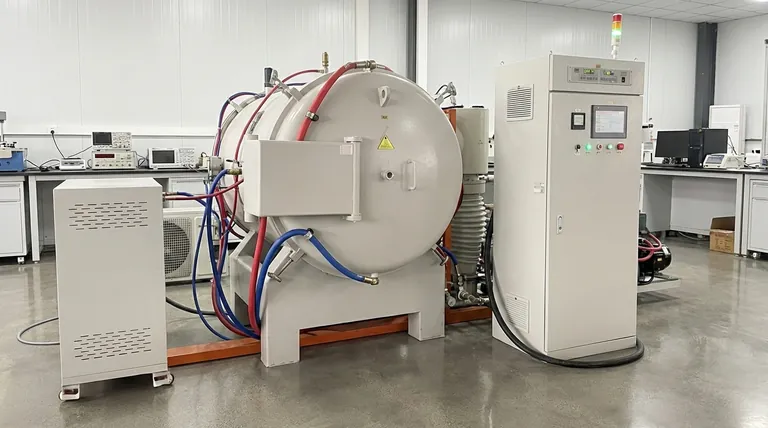In sputtering, the substrate temperature is a critical process parameter that refers to the temperature of the material, or substrate, onto which the thin film is being deposited. While the process can occur at room temperature, it is common to intentionally heat the substrate, typically within a range of 150°C to 750°C, to control and enhance the properties of the final film.
The core takeaway is that substrate temperature is not merely a background condition but a primary tool. It directly influences the mobility of deposited atoms, which in turn dictates the film's microstructure, density, adhesion, and internal stress.

Why Substrate Temperature is a Critical Control Parameter
Controlling the temperature of the substrate is fundamental to achieving the desired characteristics in the deposited thin film. The energy supplied by heating has a profound effect on the atoms as they arrive at the substrate surface.
Enhancing Surface Mobility and Adhesion
When atoms ejected from the target land on the substrate, they need to bond securely. Heating the substrate provides additional thermal energy to these atoms.
This increased energy allows the atoms to move around or "diffuse" on the surface for a short time before settling into their final positions. This enhanced mobility helps them find more stable bonding sites, which significantly improves the adhesion between the film and the substrate.
Controlling Film Microstructure
The final structure of the film—whether it is amorphous (disordered) or crystalline (ordered)—is heavily dependent on temperature.
At lower temperatures, atoms have little energy to move and are essentially frozen where they land, often resulting in an amorphous or fine-grained structure. As the temperature increases, atoms can arrange themselves into more ordered, larger crystal structures, leading to a coarse-grained polycrystalline film.
Improving Film Density and Purity
A heated substrate promotes the growth of a denser, less porous film. The added mobility allows atoms to fill in microscopic voids that would otherwise be trapped in a low-temperature deposition.
Furthermore, moderate heating can help drive off weakly bonded impurity molecules (like water vapor) from the substrate surface, leading to a purer film with better performance.
Understanding the Trade-offs and Limitations
While heating is beneficial, selecting the right temperature involves balancing competing factors. It is not always a case of "hotter is better."
Substrate Material Constraints
The most significant limitation is the thermal tolerance of the substrate itself. While a silicon wafer can handle very high temperatures, a plastic or polymer substrate would melt, deform, or outgas at much lower temperatures.
The deposition temperature must always be chosen to be safely below the substrate's degradation point.
Risk of Unwanted Diffusion and Reactions
Excessively high temperatures can cause problems. They can promote unwanted chemical reactions between the film and the substrate, creating an undesirable interface layer.
This phenomenon, known as inter-diffusion, can alter the electrical or optical properties of the film and is a major concern in semiconductor manufacturing.
Energy, Time, and Cost
Heating the chamber to high temperatures requires significant energy and adds time to the overall process for both the heating and cooling cycles.
This directly translates to higher operational costs, making it a key consideration for high-volume manufacturing environments.
Making the Right Choice for Your Goal
The optimal substrate temperature is determined entirely by the desired outcome for the thin film and the limitations of the materials involved.
- If your primary focus is maximum film density and adhesion: Use the highest temperature that your substrate can safely tolerate to maximize atom mobility.
- If your primary focus is depositing on a temperature-sensitive material (e.g., plastic): Perform the deposition at or near room temperature, and consider other techniques to improve film quality, such as ion-assisted deposition.
- If your primary focus is achieving a specific crystal structure: Temperature must be treated as a precise instrument to be carefully controlled, as different crystalline phases often form within specific temperature windows.
Ultimately, mastering substrate temperature gives you direct control over engineering the properties of your thin film at the atomic level.
Summary Table:
| Temperature Range | Primary Effect on Film | Typical Goal |
|---|---|---|
| Room Temperature | Amorphous, fine-grained | Coat sensitive substrates (e.g., plastics) |
| 150°C - 400°C | Improved adhesion, density | General-purpose quality enhancement |
| 400°C - 750°C | Coarse-grained, crystalline | Optimized electrical/optical properties |
Achieve superior thin film results with KINTEK's precision sputtering solutions.
Whether you are developing advanced semiconductors, optical coatings, or functional surfaces, precise control over substrate temperature is non-negotiable. KINTEK specializes in lab equipment and consumables that deliver the thermal stability and control your R&D or production demands.
Our expertise can help you:
- Optimize Adhesion and Density: Select the right heating configuration for your substrate and target material.
- Prevent Defects: Avoid unwanted diffusion and reactions with precise temperature management.
- Scale Your Process: From research to pilot production, we provide reliable, cost-effective solutions.
Let's engineer your perfect film. Contact our experts today to discuss your specific substrate temperature requirements and how KINTEK can support your laboratory's success.
Visual Guide

Related Products
- Molybdenum Vacuum Heat Treat Furnace
- Vacuum Heat Treat Furnace with Ceramic Fiber Liner
- 1700℃ Controlled Atmosphere Furnace Nitrogen Inert Atmosphere Furnace
- Vacuum Heat Treat Sintering Brazing Furnace
- Ultra-High Temperature Graphite Vacuum Graphitization Furnace
People Also Ask
- What is a vacuum furnace? The Ultimate Guide to Contamination-Free Thermal Processing
- What materials are used in a vacuum furnace? A Guide to Hot Zone Materials and Processed Metals
- What happens to heat generated in a vacuum? Mastering Thermal Control for Superior Materials
- Can an arc happen in a vacuum? Yes, and here's how to prevent it in your high-voltage design.
- What is the advantage of furnace brazing? Achieve Strong, Clean Joints with Minimal Distortion



















